The Concept of Dynamic Hosting Capacity for Distributed Energy Resources: Analytics and Practical Considerations
Abstract
:1. Introduction
2. Hosting Capacity Approach
3. Case Study
4. Results
4.1. Global Maximum Hosting Capacity Daily
4.2. Dynamic Hosting Capacity Profile
4.3. The Energy-Hosting Capacity Area (EHC)
4.4. Weekly Dynamic Hosting Capacity throgh Upper and Lower Limit
4.5. The Relation between the THD and DHC
5. Conclusions
Author Contributions
Funding
Acknowledgments
Conflicts of Interest
References
- Carvalho, P.M.; Correia, P.F.; Ferreira, L.A. Distributed Reactive Power Generation Control for Voltage Rise Mitigation in Distribution Networks. IEEE Trans. Power Syst. 2008, 23, 766–772. [Google Scholar] [CrossRef]
- Carvalho, P.M.S.; Ferreira, L.A.F.M.; Santana, J.J.E. Single-phase generation headroom in low-voltage distribution networks under reduced circuit characterization. IEEE Trans. Power Syst. 2015, 30, 1006–1011. [Google Scholar] [CrossRef]
- Hatziargyriou, N. MICROGRIDS—Large Scale Integration of Micro-Generation to Low Voltage Grids. In Proceedings of the CIGRE 2006, 41st Session Conference, Paris, France, April 2006. [Google Scholar]
- De Oliveira, T.E.C.; Carvalho, P.M.S.; Ribeiro, P.F.; Bonatto, B.D. PV Hosting Capacity Dependence on Harmonic Voltage Distortion in Low-Voltage Grids: Model Validation with Experimental Data. Energies 2018, 11, 465. [Google Scholar] [CrossRef]
- Ferreira, P.D.F.; Carvalho, P.M.S.; Ferreira, L.A.F.M.; Ilic, M.D. Distributed energy resources integration challenges in low-voltage networks: Voltage control limitations and risk of cascading. IEEE Trans. Sustain. Energy 2013, 4, 82–88. [Google Scholar] [CrossRef]
- Busatto, T.; Rönnberg, S.; Bollen, M.H.J. Photovoltaics and Harmonics in Low-Voltage Networks; Energiforsk: Stockholm, Sweden, 2017. [Google Scholar]
- Bollen, M.; Hassan, F. Integration of Distributed Generation in the Power System; John Wiley & Sons: Hoboken, NJ, USA, 2011. [Google Scholar]
- Santos, N.; Bollen, M.H.J.; Ribeiro, P.F. Methodology for estimation of harmonic hosting. In Proceedings of the 2014 16th International Conference on Harmonics and Quality of Power, Bucharest, Romania, 25–28 May 2014. [Google Scholar]
- Etherden, N.; Bollen, M.H.J. Increasing the hosting capacity of distribution networks by curtailment of renewable energy resources. In Proceedings of the 2011 IEEE Trondheim PowerTech, Trondheim, Norway, 19–23 June 2011. [Google Scholar]
- Bollen, M.H.J.; Rönnberg, S.K. Hosting capacity of the power grid for renewable electricity production and new large consumption equipment. Energies 2017, 10, 1325. [Google Scholar] [CrossRef]
- Rylander, M.; Smith, J.; Sunderman, W. Streamlined Method for Determining Distribution System Hosting Capacity. In Proceedings of the 2015 IEEE Rural Electric Power Conference, Asheville, NC, USA, 19–21 April 2015. [Google Scholar]
- Capitanescu, F.; Ochoa, L.F.; Member, S.; Margossian, H.; Hatziargyriou, N.D. Assessing the Potential of Network Recon fi guration to Improve Distributed Generation Hosting Capacity in Active Distribution Systems. IEEE Trans. Power Syst. 2014, 30, 346–356. [Google Scholar] [CrossRef]
- Altin, M. Distributed Generation Hosting Capacity Calculation of MV Distribution Feeders in Turkey. In Proceedings of the 2014 IEEE PES Innovative Smart Grid Technologies, Istanbul, Turkey, 12–15 October 2014. [Google Scholar]
- Baccino, F.; de Nigris, M.; Gianinoni, I.; Grillo, S.; Massucco, S.; Tironi, E. A methodology for evaluating PEVs hosting capacity margins in distribution grids. In Proceedings of the 2012 IEEE Power and Energy Society General Meeting, San Diego, CA, USA, 22–26 July 2012. [Google Scholar]
- O’Connell, A.; Smith, J.; Keane, A. Distribution feeder hosting capacity analysis. In Proceedings of the 2017 IEEE PES Innovative Smart Grid Technologies Conference Europe, Torino, Italy, 26–29 September 2018. [Google Scholar]
- Sáiz-marín, E.; Member, S.; Lobato, E.; Egido, I. Local Hosting Capacity Increase by Means of Wind Farm Voltage Control Provision. IEEE Trans. Power Syst. 2014, 29, 1731–1738. [Google Scholar] [CrossRef]
- Dubey, A.; Santoso, S. On Estimation and Sensitivity Analysis of Distribution Circuit’s Photovoltaic Hosting Capacity. IEEE Trans. Power Syst. 2017, 32, 2779–2789. [Google Scholar] [CrossRef]
- Abdel-salam, M.; Ziedan, H.; Kamel, R.M.; Sayed, K. Effect of Micro-Grid Renewable Micro-sources on Short Circuit Capacity of Hosting Distribution Networks. In Proceedings of the 35th International Telecommunications Energy Conference, Hamburg, Germany, 13–17 October 2013. [Google Scholar]
- Harrison, G.P.; Djokic, S.Z. Incorporating harmonic limits into assessment of the hosting capacity of active networks. In Proceedings of the CIRED 2012 Workshop: Integration of Renewables into the Distribution Grid, Lisbon, Portugal, 29–30 May 2012. [Google Scholar]
- Arshad, A.; Lindner, M.; Lehtonen, M. An analysis of photo-voltaic hosting capacity in finnish low voltage distribution networks. Energies 2017, 10, 1702. [Google Scholar] [CrossRef]
- Falabretti, D.; Merlo, M.; Delfanti, M. Network Reconfiguration and Storage Systems for the Hosting Capacity Improvement. In Proceedings of the 22nd International Conference on Electricity Distribution, Stockholm, Sweden, 10–13 June 2013. [Google Scholar]
- Schwaegerl, C.; Bollen, M.H.J.; Karoui, K.; Yagmur, A. Voltage control in distribution systems as a limitation of the hosting capacity for distributed energy resources. In Proceedings of the IET CIRED Conference, Turin, Italy, 6–9 June 2005. [Google Scholar]
- Ryckaert, W.R.A.; Ghijselen, J.A.L.; Melkebeek, J.A.A. Harmonic mitigation potential of shunt harmonic impedances and the influence of background distortion. In Proceedings of the 2003 IEEE Bologna Power Tech Conference Proceedings, Bologna, Italy, 23–26 June 2003. [Google Scholar]
- Ribeiro, P.F.; Leitao, J.J.A.L.; Lira, M.M.S.; Macedo, J.R.; Grandi, A.L.Z.; Testa, A.; Langella, R.; Cobben, J.F.G.; Browne, N.R. Harmonic distortion during the 2010 FIFA World Cup. In Proceedings of the 2011 IEEE Power and Energy Society General Meeting, San Diego, CA, USA, 24–29 July 2011. [Google Scholar]
- Ghijselen, J.A.; Ryckaert, W.R.; Melkebeek, J.A. Required Load Behaviour for Power. In Proceedings of the IEEE Power Engineering Society Summer Meeting, Chicago, IL, USA, 21–25 July 2002. [Google Scholar]
- Macedo, R.J.; Carneiro, V.J.R.; Martins, G.A.; Siqueira, V.M.J. The impact of FIFA World Cup 2006 on Power. In Proceedings of the 2007 9th International Conference on Electrical Power Quality and Utilisation, Barcelona, Spain, 9–11 October 2017. [Google Scholar]
- Leitão, J.J.A.L.; Fonseca, L.C.A.; Lira, M.M.S.; Soares, L.R.; Ribeiro, P.F. Harmonic distortion on a transmission system during games of the Brazilian National Team in the 2006 world cup. In Proceedings of the 2007 IEEE Power Engineering Society General Meeting, Tampa, FL, USA, 24–28 June 2007. [Google Scholar]
- Testa, A.; Langella, R. Harmonic pollution in Italian distribution networks in coincidence with important sport events. In Proceedings of the 2007 IEEE Power Engineering Society General Meeting, Tampa, FL, USA, 24–28 June 2007. [Google Scholar]
- Bollen, M.H.J.; Hager, M. Power Quality: Interactions Between Distributed Energy Resources, the Grid, and Other Customers. Electr. Power Qual. Util. Mag. 2005, 1, 51–61. [Google Scholar]
- Ribeiro, P.F.; Polinder, H.; Verkerk, M. Planning and designing smart grids: Philosophical considerations. IEEE Technol. Soc. Mag. 2012, 31, 34–43. [Google Scholar] [CrossRef]
- De Oliveira, T.E.C.; Ribeiro, P.F.; Santos, I.N. Determining the harmonic hosting capacity of PV sources for a university campus. In Proceedings of the 2016 17th International Conference on Harmonics and Quality of Power, Belo Horizonte, Brazil, 16–19 October 2016. [Google Scholar]
- De Oliveira, T.E.C.; Bonatto, B.D.; Filho, J.M.C.; Ribeiro, P.F.; Santos, I.N. Análise Econômica da Hospedagem de Fontes de Geração Distribuída no Sistema Elétrico de um Campus Universitário. In Proceedings of the An. do CBQEE 2015—XI Conferência Bras. sobre Qual. da Energ. Elétrica, Campina Grande, Paraíba, Brazil, 7–10 June 2015. [Google Scholar]
- MAthari, H.; Wang, Z.; Eylas, S.H. Time-series analysis of photovoltaic distributed generation impacts on a local distributed network. In Proceedings of the 2017 IEEE Manchester PowerTech, Manchester, UK, 18–22 June 2017. [Google Scholar]
- Fan, S.; Pu, T.; Li, L.; Yu, T.; Yang, Z.; Gao, B. Evaluation of impact of integrated distributed generation on distribution network based on time-series analysis. In Proceedings of the 2016 China International Conference on Electricity Distribution (CICED), Xi’an, China, 10–13 August 2016. [Google Scholar]
- Smith, J. Modeling and Hosting Capacity Analysis of 16 Feeders; Electric Power Research Institute: Palo Alto, CA, USA, 2015. [Google Scholar]
- Rylander, M.; Smith, J.; Lewis, D.; Steffel, S. Voltage impacts from distributed photovoltaics on two distribution feeders. In Proceedings of the 2013 IEEE Power & Energy Society General Meeting, Vancouver, BC, Canada, 21–25 July 2013. [Google Scholar]
- Zhu, D.; Jain, A.K.; Broadwater, R.; Bruna, F. Feeder Voltage Profile Design for Energy Conservation and PV HostingCapacity Enhancement. Electr. Power Syst. Res. 2018, 164, 263–271. [Google Scholar] [CrossRef]

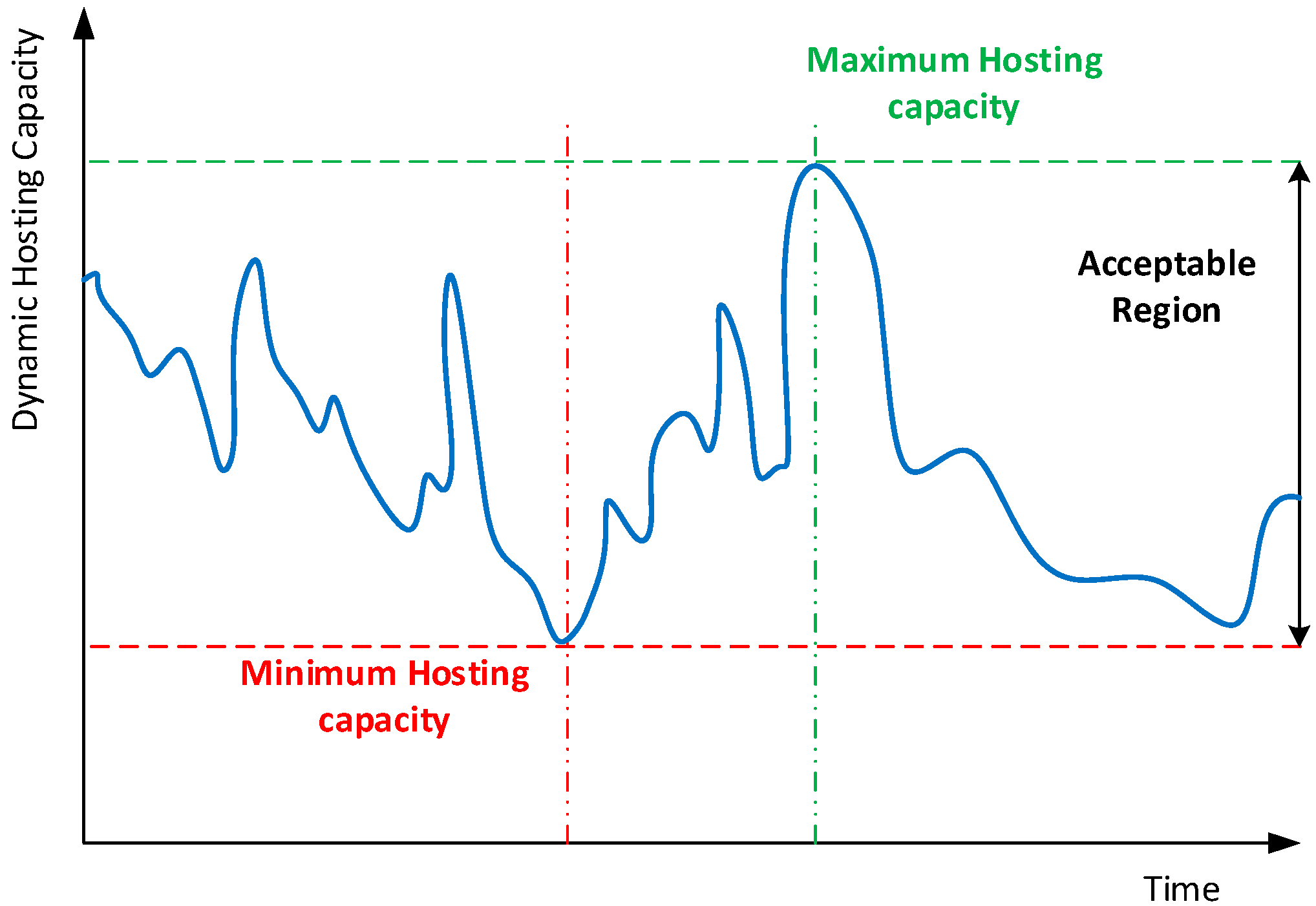
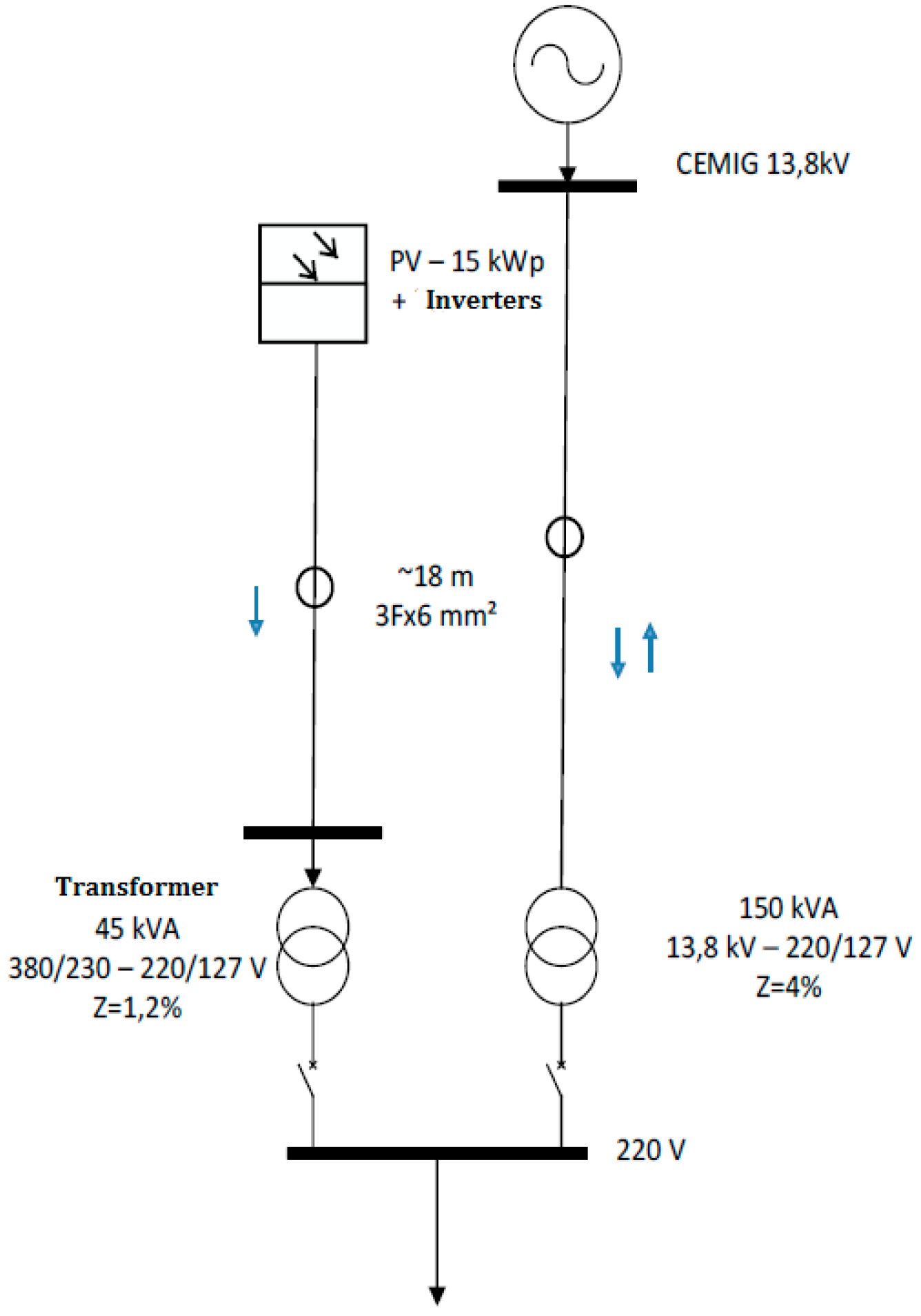
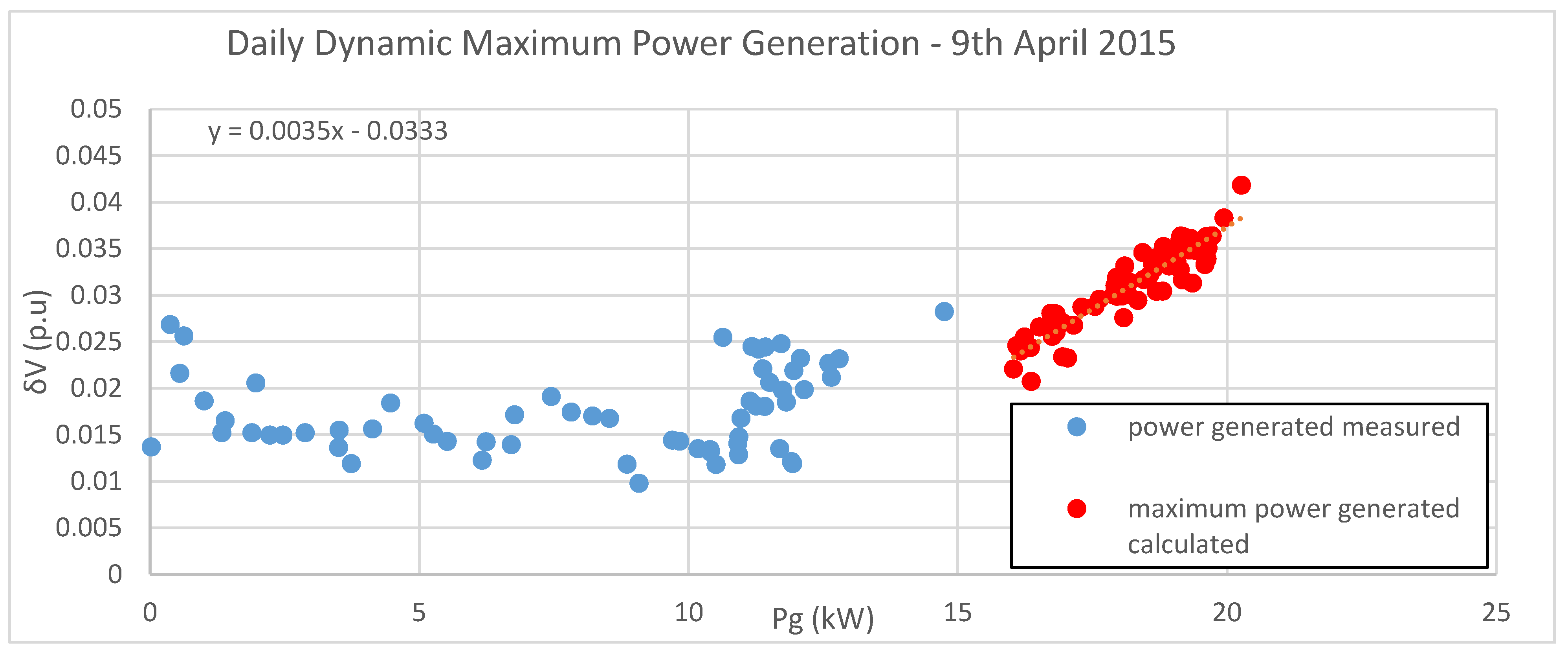
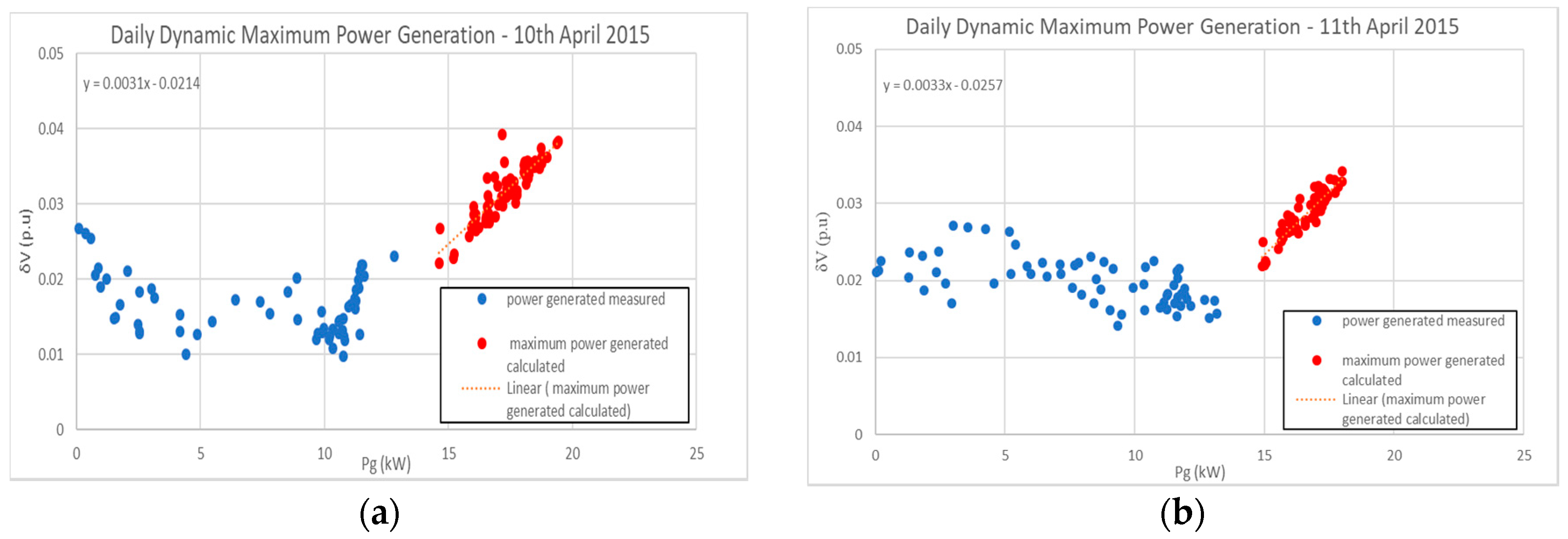

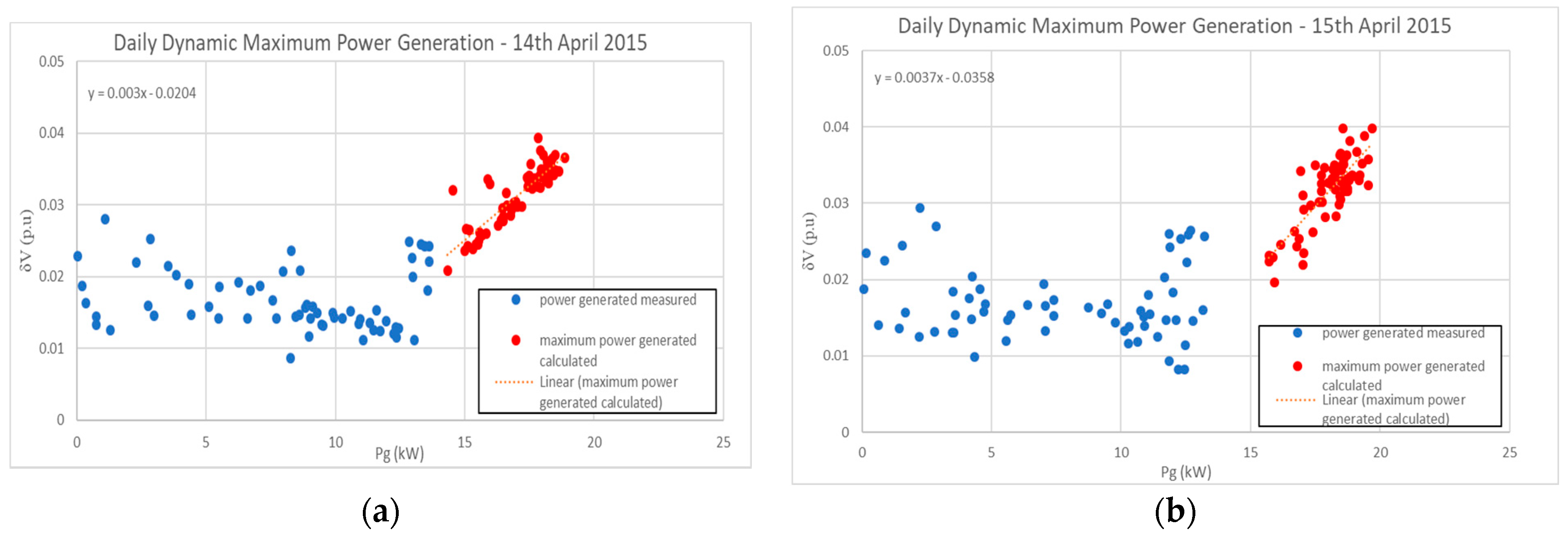
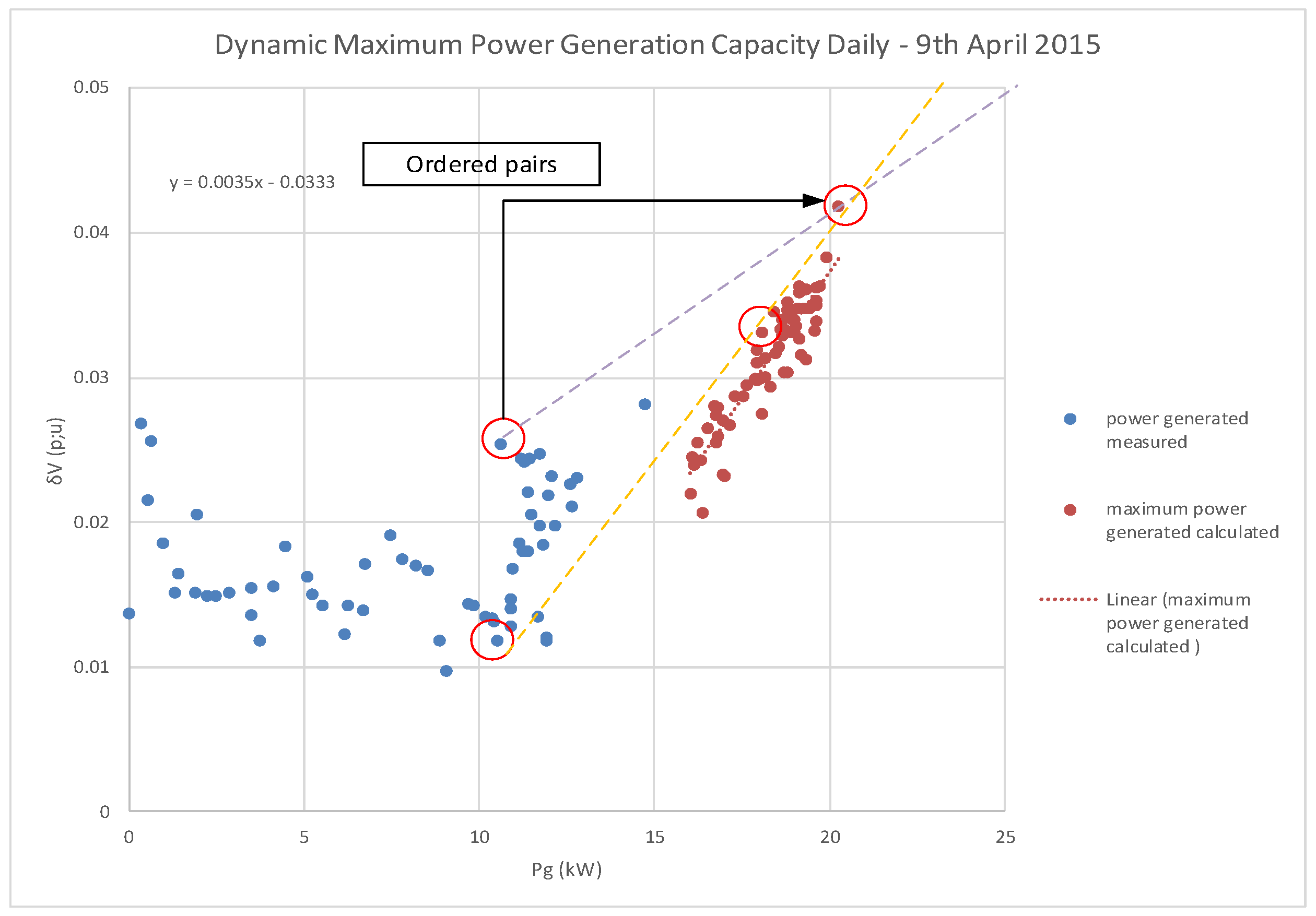
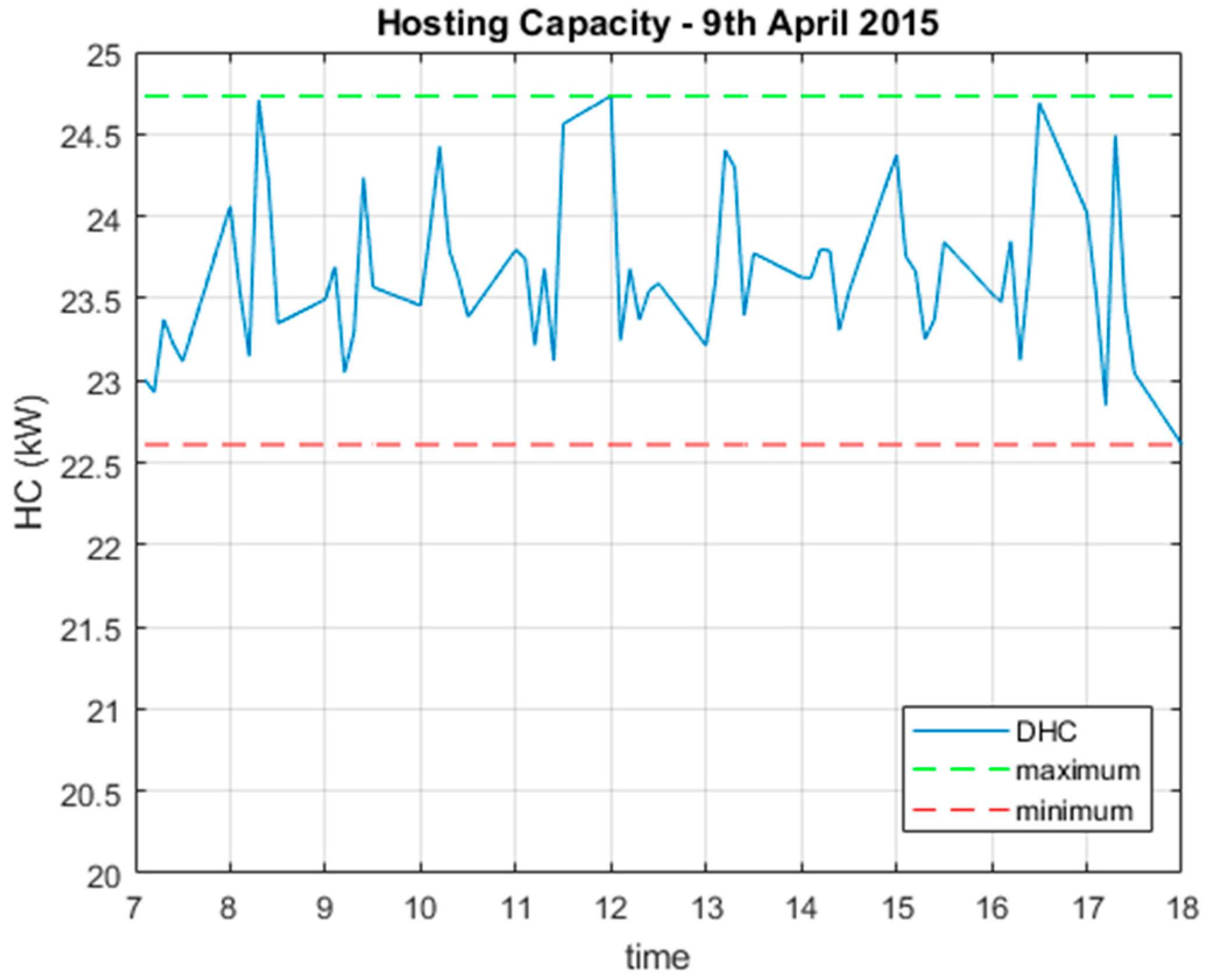
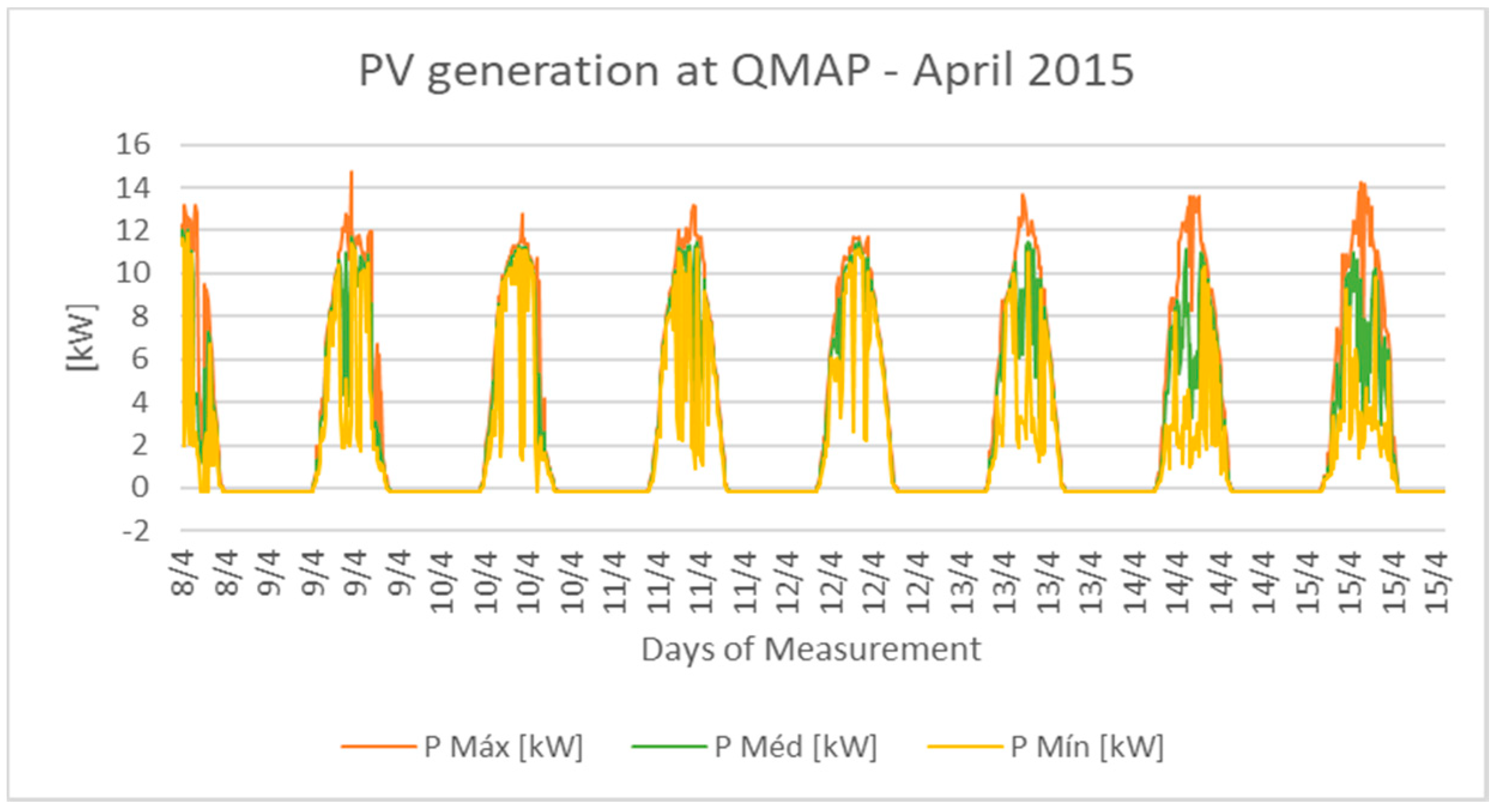

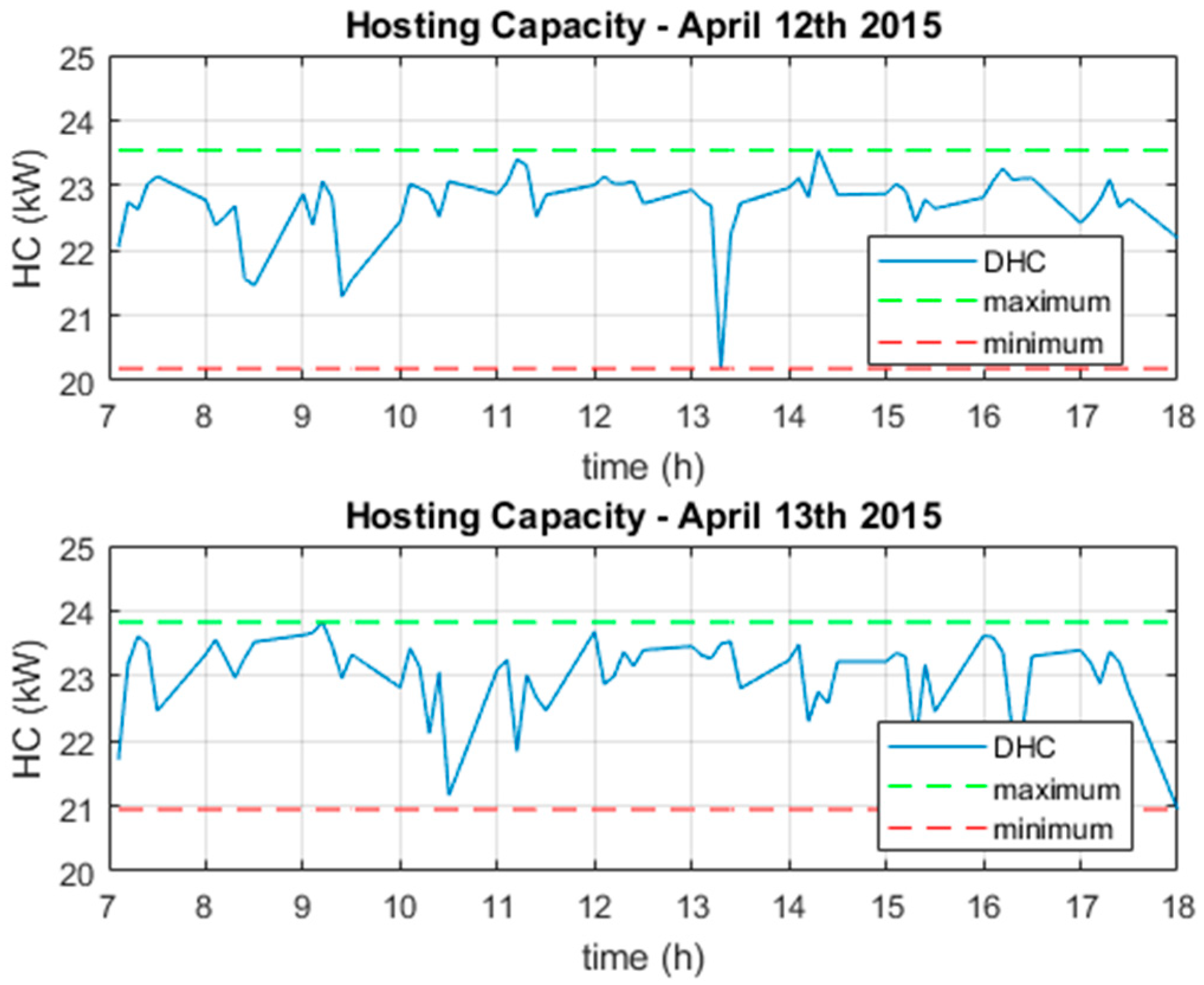
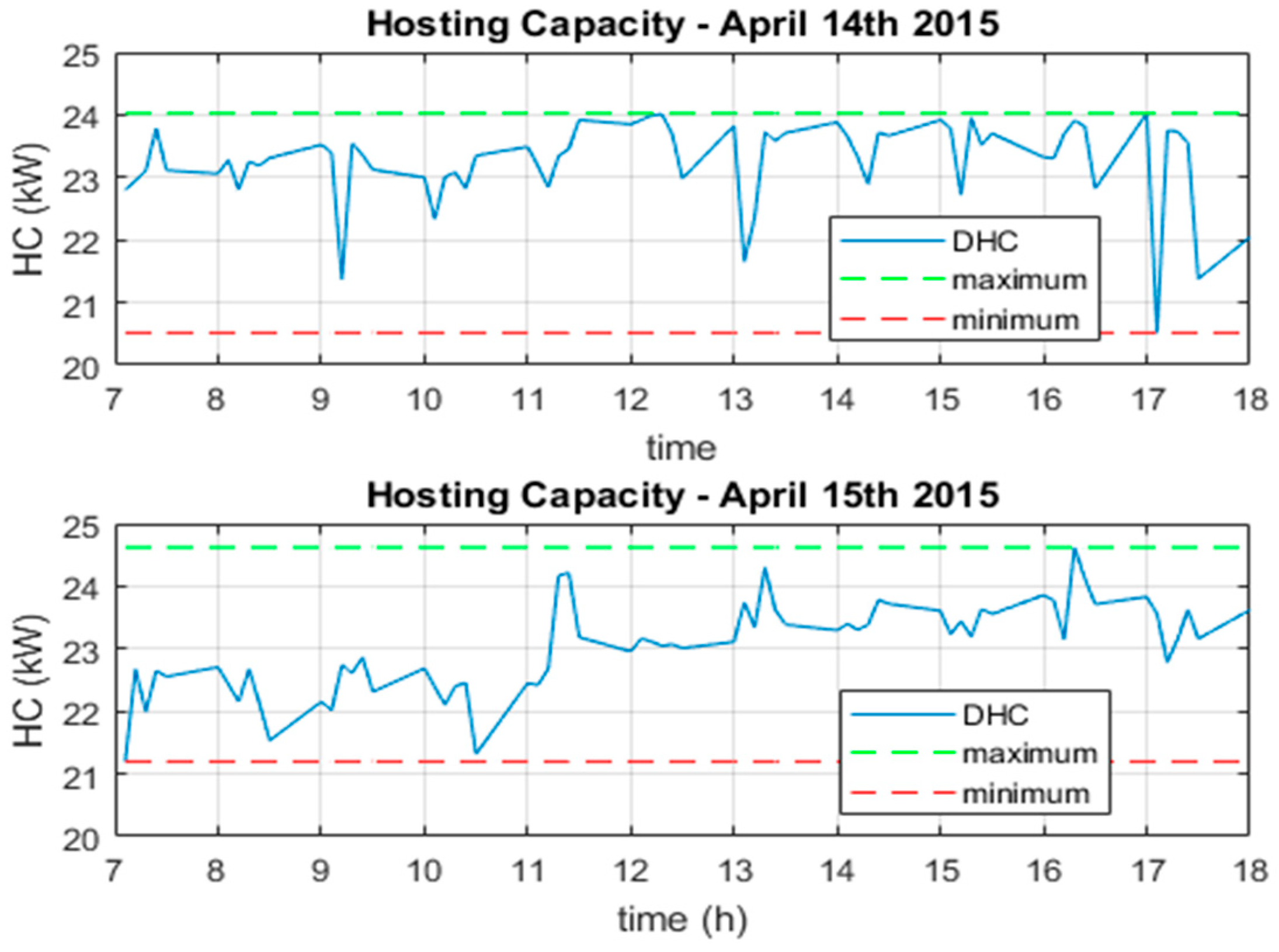

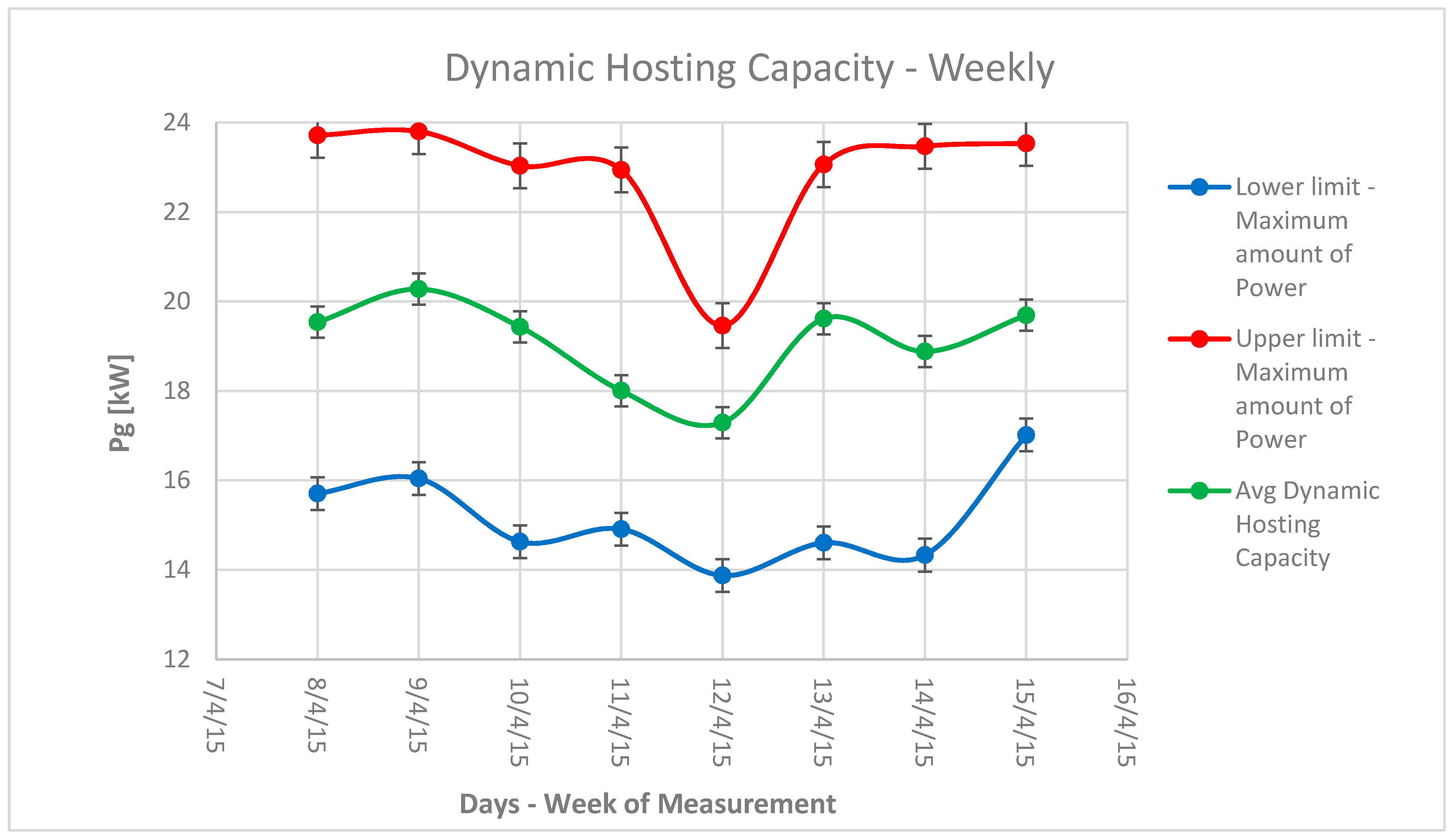
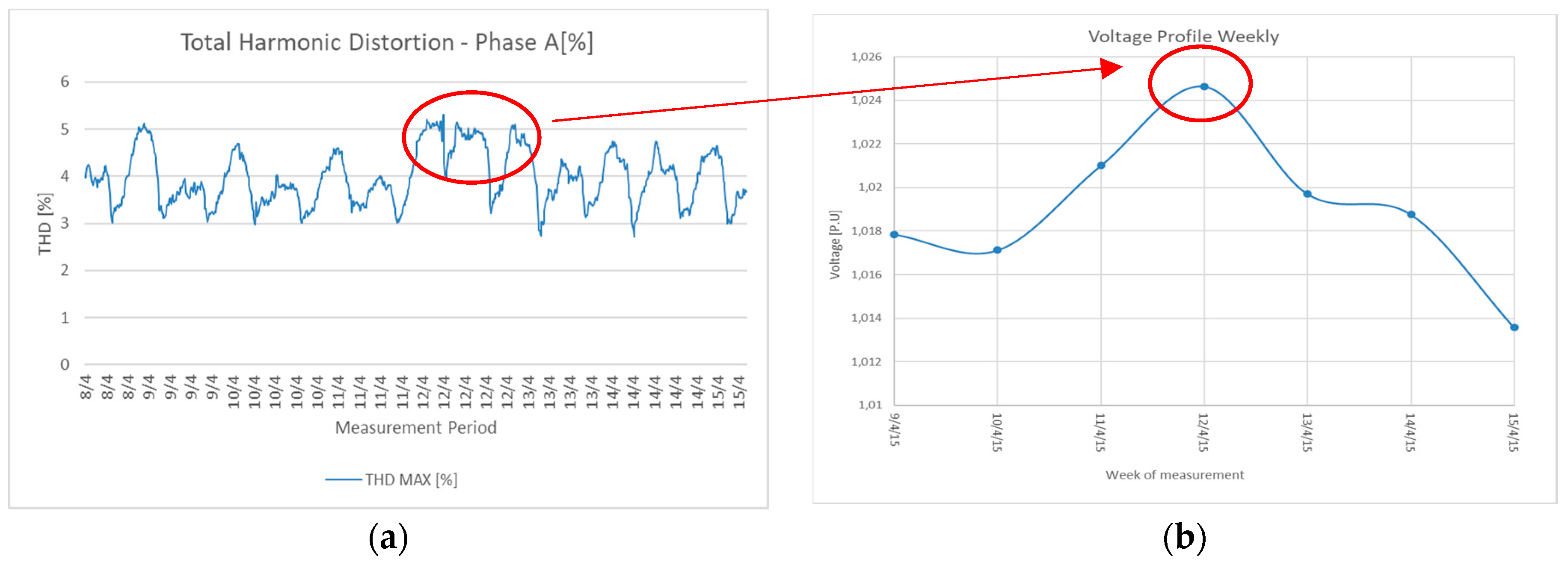
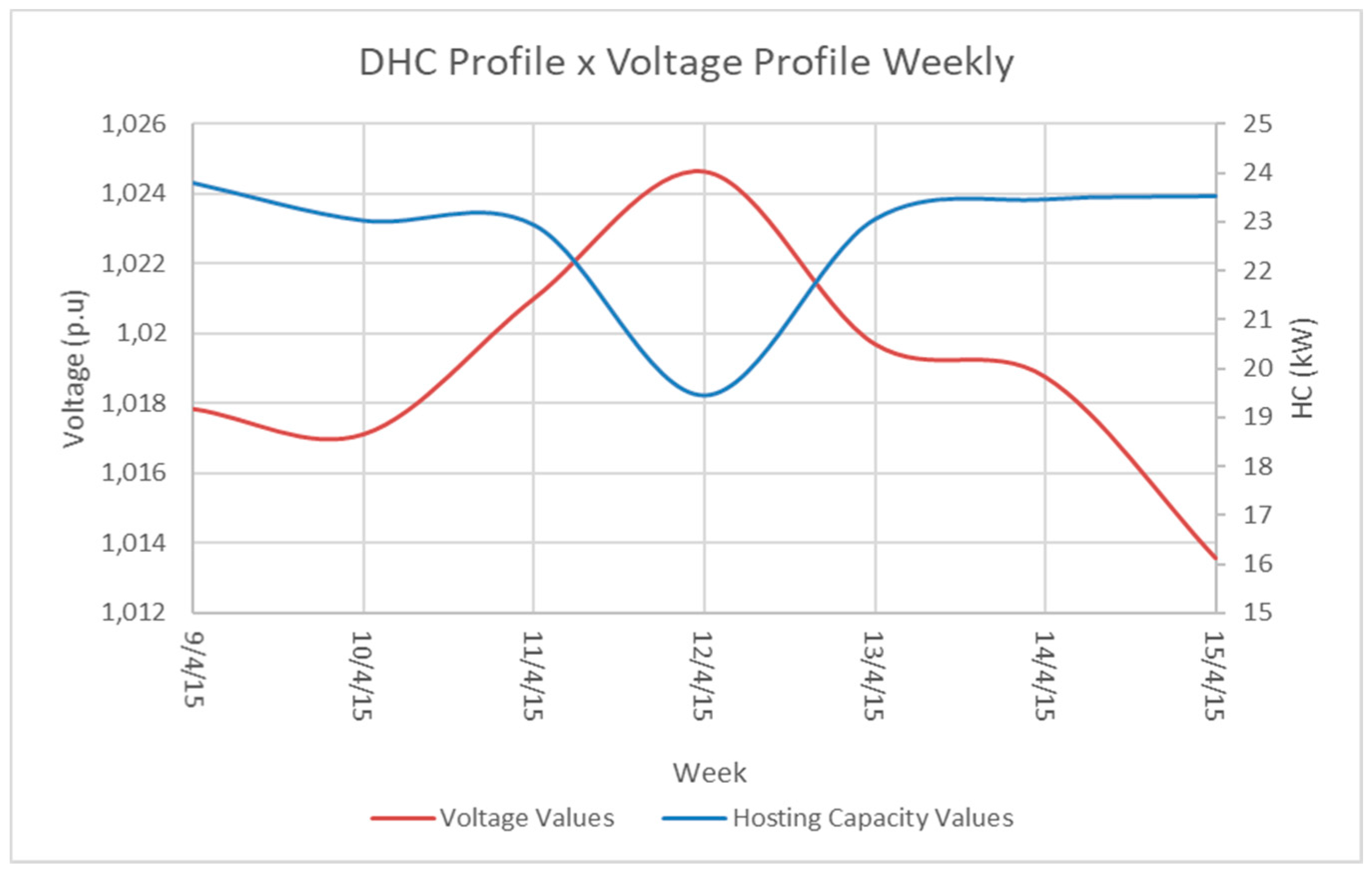
| Parameter | Default Value |
|---|---|
| Autotransformer | 45 kVA, 380/230–220/127 V, Z = 1.2% |
| Transformer | 150 kVA 13.8 kV–220/127 V, Z = 4% |
| PV Cable | 18 m, 3P × 6 , Cu |
| PV system + Inverters | 15 + 2 Inverters (7.5 kW) |
| CEMIG 13.8 kV | Scc = 1000 MVA |
| Date | April 9th | April 10th | April 11th | April 12th | April 13th | April 14th | April 15th |
|---|---|---|---|---|---|---|---|
| HC | 24 kW | 23.5 kW | 23.4 kW | 19.5 kW | 23.3 kW | 23.6 kW | 23.6 KW |
| Day | Daily EHC (kWh) | Max PV Production (kW) |
|---|---|---|
| 09/04/2015 | 50.95374 | 14.7561 |
| 10/04/2015 | 82.81773 | 12.8069 |
| 11/04/2015 | 36.94982 | 13.1786 |
| 12/04/2015 | 80.47586 | 11.7228 |
| 13/04/2015 | 69.1255 | 13.6711 |
| 14/04/2015 | 84.26921 | 13.6245 |
| 15/05/2015 | 82.18106 | 14.2848 |
© 2019 by the authors. Licensee MDPI, Basel, Switzerland. This article is an open access article distributed under the terms and conditions of the Creative Commons Attribution (CC BY) license (http://creativecommons.org/licenses/by/4.0/).
Share and Cite
Castelo de Oliveira, T.E.; Bollen, M.; Ribeiro, P.F.; de Carvalho, P.M.S.; Zambroni, A.C.; Bonatto, B.D. The Concept of Dynamic Hosting Capacity for Distributed Energy Resources: Analytics and Practical Considerations. Energies 2019, 12, 2576. https://doi.org/10.3390/en12132576
Castelo de Oliveira TE, Bollen M, Ribeiro PF, de Carvalho PMS, Zambroni AC, Bonatto BD. The Concept of Dynamic Hosting Capacity for Distributed Energy Resources: Analytics and Practical Considerations. Energies. 2019; 12(13):2576. https://doi.org/10.3390/en12132576
Chicago/Turabian StyleCastelo de Oliveira, Tiago Elias, Math Bollen, Paulo Fernando Ribeiro, Pedro M. S. de Carvalho, Antônio C. Zambroni, and Benedito D. Bonatto. 2019. "The Concept of Dynamic Hosting Capacity for Distributed Energy Resources: Analytics and Practical Considerations" Energies 12, no. 13: 2576. https://doi.org/10.3390/en12132576
APA StyleCastelo de Oliveira, T. E., Bollen, M., Ribeiro, P. F., de Carvalho, P. M. S., Zambroni, A. C., & Bonatto, B. D. (2019). The Concept of Dynamic Hosting Capacity for Distributed Energy Resources: Analytics and Practical Considerations. Energies, 12(13), 2576. https://doi.org/10.3390/en12132576









